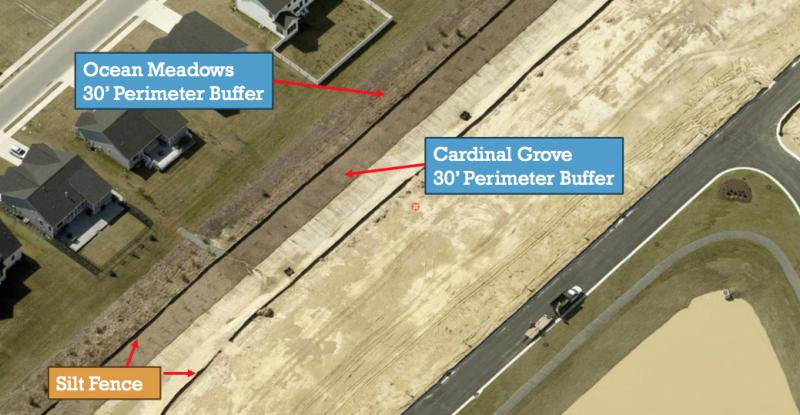Sussex perimeter buffer regs include a protection zone
Sussex County Council received an outline of possible recommendations to update the perimeter buffer ordinance during its Dec. 12 meeting.
Sussex County Administrator Todd Lawson said the process to rewrite an ordinance will include three steps. The first was presentation of an outline, before specifics are identified following feedback from council, the public and stakeholders. The third step will be drafting of a new ordinance.
“Now, perimeter buffers are not a priority. Developers do not pay much attention to it, or if trees live or die. They just walk away,” Lawson said.
The key provisions include a new 20-foot protection area to protect perimeter buffers; a five-year look back to mitigate clear-cut perimeter buffer areas; perimeter buffers in place before building permits are issued; and a proposal that perimeter buffer and protection areas be delineated and protected prior to the notice to proceed for site work to begin.
Lawson said he will return with more specifics for council discussion in early 2024.
Five-year look back
The proposed ordinance incentivizes saving existing trees to be used in a perimeter buffer. The proposed standards would include a five-year look back if the area for the perimeter buffer is harvested within five years of an application being filed.
The perimeter buffer woods removed would be measured to determine the acreage that was harvested. The perimeter buffer would be planted with double the number of trees and shrubs, including 15 plantings for every 50 feet. The perimeter buffer would have a protection area as well.
A new area double the size of the harvested perimeter buffer trees would be planted or preserved either on the parcel or on a nearby parcel.
“We want the bulldozers to stop and make sure trees stay in place. We are asking to stop tree clearing up to the property line,” Lawson said.
Lawson used the Brentwood subdivision on Robinsonville Road as an example. Of the nearly 150 acres of trees cut down, those within the 30-foot perimeter buffer would equate to a little more than 7 acres, which would require 14 acres of new trees.
“We want to stop destruction 30 feet from property lines,” Lawson said.
Timing, bonds, guarantees
When woodlands already exist, the perimeter buffer and protection area must be delineated and protected before the notice to proceed is issued for site work to begin.
A performance bond of 125% of the cost of installing the perimeter buffer and the value of replacement plantings, or $50,000, whichever is greater, would be required.
A developer would be responsible for survival of the perimeter buffer for two years.
A landscape plan
The landscape plan would include: approximate location of silt fencing; location, height and species of new trees and shrubs; location of perimeter buffer signage; a planting schedule; and a survey of new trees to be planted and existing trees to be used.
Perimeter buffers can be created by phase but must be completed before the issuance of the first building permit.
Mitigation
Tree mitigation would be required when perimeter buffer or protection areas in existing woodlands are damaged. A plan would be developed by a licensed professional. The mitigation rate of three trees for every one tree removed or damaged would be required.
Is 30 feet enough?
Lawson said the current ordinance requires a 30-foot perimeter buffer. “Is 30 feet enough?” he asked.
In addition, Lawson said, there is support to provide a 20-foot protection area beyond the current 30 feet. “It’s a buffer of the buffer to preserve trees in the buffer,” Lawson said.
Lawson said county staff will seek feedback from the engineering community to see if a protection-area buffer is possible and not a burden to a developer.
Lawson said the current ordinance is not specific on what can or cannot be planted in a buffer. He said native plantings should be required as determined by certified forestry officials.
Per code today, 15 trees per 100 feet are required, with 70% deciduous and 30% evergreens planted at a height of 6 feet.
While permanent signs are required to mark out-of-bounds areas, such as perimeter buffers, Lawson said a new ordinance could strengthen that requirement by codifying it.
The administrator said the expectation is that buffers grow and survive, and if a developer feels irrigation is needed to achieve that, it must be provided.
The proposed 20-foot width for protection areas is up for debate, Lawson said.
He said the proposed 20-foot protection area is not based on science. “All research I’ve done shows larger than 20-foot areas. We need input from experts,” he said.
Proposals
For existing wooded perimeter buffers:
• A forest assessment by a certified professional
• Woodlands shown on site and landscape plans
• Woodlands must be kept in a natural state with limited activity
• Perimeter buffers (30 feet wide) would be protected by a perimeter buffer protection area (20 feet wide)
• Perimeter buffers and protection areas would have a silt fence and be clearly marked during construction
• Selective clearing, removal of invasive species and dead trees would be permitted
• All perimeter buffers and protection areas would have a two-year guarantee.
With no woods:
• Developer must adhere to perimeter buffer standards
• A newly planted perimeter buffer would have a two-year guarantee with the developer responsible to replace any losses.






















































